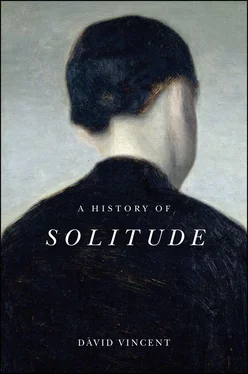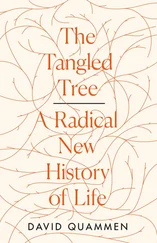This long catalogue of the numerous causes which conduct to Solitude, is closed by Religion and Fanaticism. The former leads to the serenity and quiet of retirement, from the purest and noblest of considerations, the best propensities, and the finest energies. It is the passion of the strongest and best regulated minds. The latter is a rebellion against nature; a violation and perversion of reason; a renunciation of virtue; the folly and vice of narrow and oblique understandings; produced by a misapprehension of the Deity, and an ignorance of themselves. 50
Zimmermann had no argument with religion itself. A Swiss Protestant, he was at ease with his denomination’s mixed economy of private prayer and collective worship. His problem was with the eremitical tendency in the Catholic Church, whose influence had been curtailed but by no means obliterated by the Reformation. The objection was not just to current monastic practice, limited as it was even in the Catholic regions of Europe. Rather, Zimmermann was exercised by the broader status and moral authority of the tradition of seclusion rooted in the desert hermits of the fourth century, who in turn were seeking to replicate Christ’s sojourn in the wilderness. 51He aimed his fire directly at the founding fathers of the Catholic Church: ‘So far were these madmen, who are deemed to be the stars of the infant Church, from understanding human nature, that they employed their knowledge to exact from themselves and their proselytes everything unnatural and impracticable.’ 52What he repeatedly termed ‘fanaticism’ had no place in the rational, sociable culture of late eighteenth-century urban Europe. 53
Zimmermann’s point of departure lay in his conception of how to live. Although an observant Christian, he had no sense that a silent, intensely personal communion with God was the ultimate purpose of man’s time on earth. Solitude Considered was a treatise on the pursuit of happiness, centred on the individual’s inherent sociability. The irreversible rejection of comfort and company represented a perversion of human nature. Zimmermann’s problem was with those who, ‘instigated by religious fervour, and perceiving nothing but corruption in the joys of social life, and sinful abomination in its virtues, retire from the spectacle to contemplate in the sacred gloom of the monastery, or the solitude of the cave and desert, a Being whose essence is unalterable purity, unlimited goodness and perfection’. 54He took issue with a spiritual tradition that argued, in the words of the seventeenth-century Cistercian Cardinal Bona, that ‘no one can find God except he is solitary, for God himself is alone and solitary’. 55At best, such a public renunciation of society was a form of self-indulgence. Zimmermann was of the same view as John Evelyn that the practice trivialized rather than grounded Christian worship. ‘Verily,’ wrote Evelyn, ‘there is more of Ambition and empty glory in some Solitudes , and affected Retreats , than in the most expos’d and conspicuous actions whatsoever: Ambition is not only in publick places, and pompous circumstances; but at home , and in the interior life; Heremits themselves are not recluse enough to seclude that subtile spirit, Vanity.’ 56At worst, it overlapped with other forms of insanity. ‘Religious melancholy’ was seen as a particularly lethal category of mental illness. ‘All authors who have treated this subject,’ noted John Haslam in his Observations on Madness and Melancholy of 1809, ‘appear to agree respecting the difficulty of curing religious madness.’ 57The human mind was incapable of coping alone with the consequences of seeking out the most profound spiritual revelations. Christian observance was entirely beneficial, continued Haslam, ‘but when an anxious curiosity leads us to unveil that which must ever be shrouded from our view, the despair, which always attends these impotent researches, will necessarily reduce us to the most calamitous state’. 58This category of melancholy remained part of the diagnostic tool-kit of nineteenth-century doctors, and still featured in Krafft-Ebbing’s compendious textbook on insanity in 1904. 59
In his discussion of religious fanaticism, Zimmermann drew a distinction between continental Europe and its outlying nation, where the monasteries had not recovered from the Reformation. ‘An Englishman,’ he wrote, ‘when melancholy, shoots himself; a melancholy Frenchman used to turn Carthusian.’ 60In a country where the only visible hermits were those employed to inhabit grottos for the entertainment of visitors to newly landscaped country estates, monastic seclusion did not appear an immediate threat to the good ordering of religious practice. 61However, in Britain as elsewhere, Enlightenment rationalism was at odds in the eighteenth century with forms of religious enthusiasm that foregrounded a direct encounter with God by the impassioned believer. Anglican and nonconformist evangelicalism had yet to generate new institutional contexts for such personal communication, but the tradition of the desert fathers remained alive and towards the end of the eighteenth century was stimulating interest amongst theologians. While Solitude Considered was going through successive English editions in the 1790s, the Reverend James Milner began publishing his influential History of the Church of Christ , which sought to educate the clergy and laity in the lives and work of the early Christians. He argued for greater, though not uncritical, respect for the monastic tradition: ‘We often hear it said, How ridiculous to think of pleasing God by austerities and solitude! Far be it from me to vindicate the superstitions of monks, and particularly the vows of celibacy. But the error is very natural, has been reprehended much too severely and the profaneness of men of the world is abundantly more dangerous.’ 62Alongside this cautious defence of religious solitude, popular interest in the ‘superstitions’ of the Catholic churches was heightened by the outbreak of war in 1793 with Britain’s nearest Catholic neighbour. The outcome was the publication in 1796 of a novel still more sensational than Zimmermann’s treatise.
Matthew Lewis’s The Monk created a template for a category of vigorous, sometimes salacious attacks on enclosed religious institutions that was to flourish throughout much of the succeeding century in both fiction and non-fiction. The novel was written when its precocious author was still only nineteen, following a stay in Weimar to learn German. 63Lewis met and translated Goethe, but there is no evidence that he encountered the Hanover-based Zimmermann either in person or in his writings. Although Lewis was widely accused of plagiarism, the sources were generally held to be the fertile German tradition of Schauerromane (shudder stories) together with home-grown gothic novels, particularly Horace Walpole’s Castle of Otranto of 1764, and, more immediately, Ann Radcliffe’s Mysteries of Udolpho of 1794. 64His attack on the perversions inherent in monasteries and nunneries reflected a wider Enlightenment sensibility of which Zimmermann was merely a representative figure. Denis Diderot’s La Religieuse , written in 1760 but not published until 1796, described in vivid detail the sufferings of a reluctant nun, confined to ‘a little dark underground chamber, where I was thrown on to a mat half-rotten with damp’, when she attempts to leave her convent. 65Lewis’s story soon took off into realms of gothic fantasy that were entirely at odds with the ordered universe of the Swiss doctor. But early in the novel he wrote a speech which exactly captured Zimmermann’s objection to eremitical living. The eponymous Monk, Ambrosio, addresses a young man, Rosario (soon to be revealed as the cross-dressing sorceress Matilda, the Monk’s fatal nemesis), who has taken up residence in a hermitage in the monastery grounds:
Читать дальше












